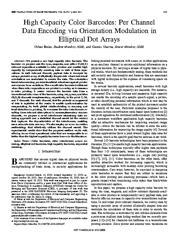A copy of this work was available on the public web and has been preserved in the Wayback Machine. The capture dates from 2017; you can also visit the original URL.
The file type is application/pdf.
High Capacity Color Barcodes: Per Channel Data Encoding via Orientation Modulation in Elliptical Dot Arrays
2011
IEEE Transactions on Image Processing
We present a new high capacity color barcode. The barcode we propose uses the cyan, magenta, and yellow (C,M,Y) colorant separations available in color printers and enables high capacity by independently encoding data in each of these separations. In each colorant channel, payload data is conveyed by using a periodic array of elliptically shaped dots whose individual orientations are modulated to encode the data. The orientation based data encoding provides beneficial robustness against printer
doi:10.1109/tip.2010.2092437
pmid:21078575
fatcat:dquw2sja2rayzoxpcth46cvhu4

